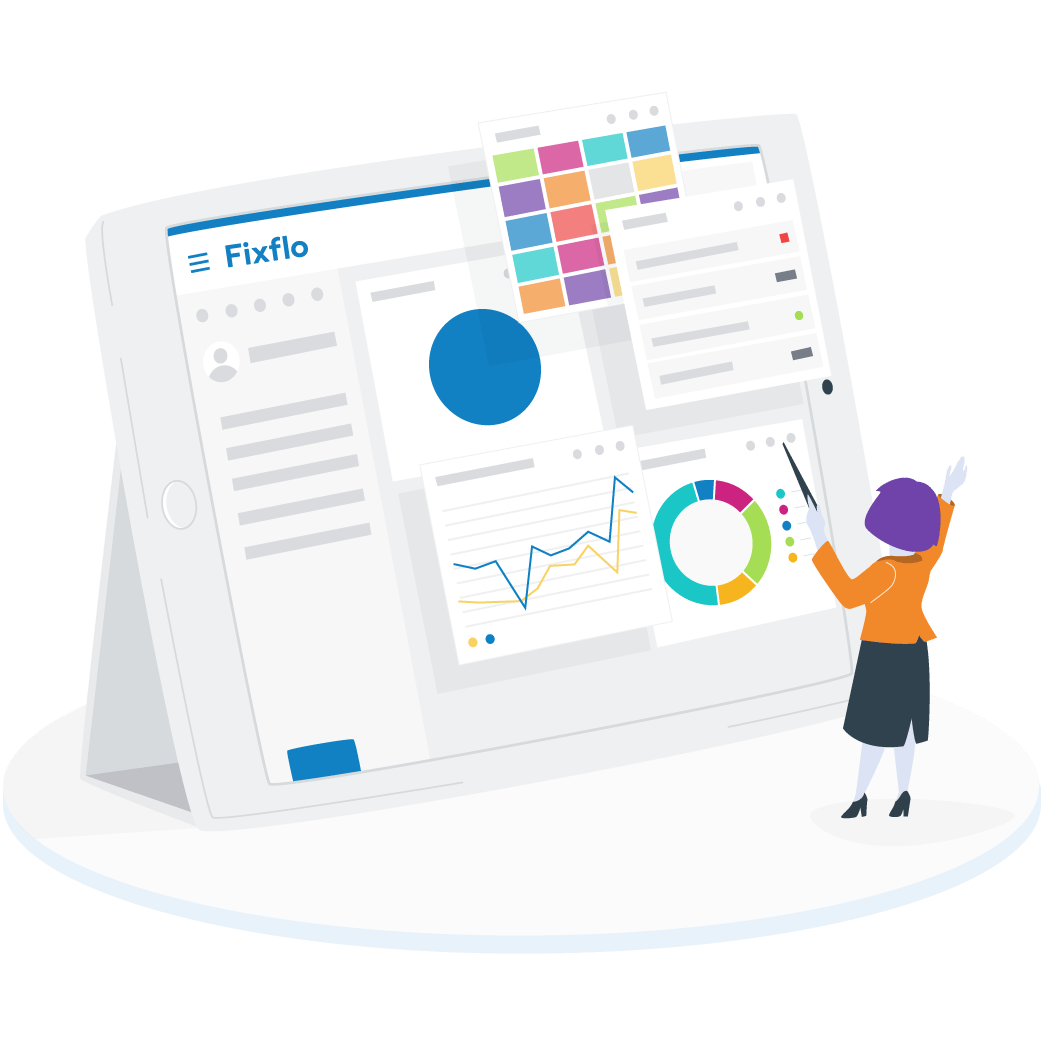A tech stack is a combination of software systems and apps that are integrated on top of each other and are able to share data. The term began in web and app development, referring to the combination of technologies an organisation would use to build web and mobile applications. It has since spread to other industries, including the property sector, where property management companies and letting agencies combine different proptech technologies to create their perfect digital solutions.
What is a tech stack?

Why are tech stacks important?
In most cases, tech solutions can work well in a company without integration. When handled by a process-driven team, these 'standalone' systems can give good results. However, when teams change or procedures alter, standardised workflows are not always followed ideally in every company. A fully integrated tech stack could automate processes, making it easier for a team to standardise their workflows.
Technology can be a huge performance driver, but inefficient usage can hinder this. You may simply be using one property management system for managing everything to do with your business—but is this doing the best job, or could it be a 'jack of all trades, master of none'?
Why you should build a tech stack
If the systems you use in your agency can't communicate with each other, this presents an opportunity to streamline some processes.
Prevents conflicting data
Details such as addresses and contact information for occupiers, contractors or landlords may have to be entered manually more than once depending on which system needs it. When data conflicts occur across different systems, confusion and errors will likely occur.
This is why siloed systems pose a problem for reporting – they cannot bring together this information in an effective way. To paint an accurate picture of your team's performance, you need to be able to pull together information from multiple systems in one place.
Streamline user access
A tech stack will streamline your company's user access and team member onboarding. Managing multiple systems means each system requires a different login, which poses a logistical challenge every time you hire a new property manager.
When your tech stack works well, it should allow your team to access the data they need from the system they use most of the time, including data from another integrated system. This also applies to training. Think of the time and money spent training each new team member to use different systems when they could have everything in one place.
Scalability
It’s much easier to scale up with a tech stack. Scalability should be a key consideration because the return on investment (ROI) can be significant in the productivity-to-headcount ratio, especially where experienced employees are difficult to hire and retain.
New tools that integrate with your property management system pull the data from this system rather than requiring manual data entry. This will save time and resources and reduce the risks of conflicting data as you expand your service offering. An example is a video maintenance solution that integrates with property management systems.
How do property management organisations use tech stacks?
A central property management system (PMS) integrating with a specialist repairs and maintenance solution like Fixflo is a simple example of using a tech stack in the private rented sector. The solution could pull across maintenance works and risk assessment data such as messages sent between the property manager and the contractor and the approval status of a quotation. Users of the PMS could be provided with real-time updates as a result.
The reactive repairs process
A property manager conducting a periodic inspection notices the front door isn't locking properly.
The property manager takes a photo of the door and logs the issue in their property inspection app on their mobile phone. The property inspection app’s APIs send the issue details to the maintenance management solution.
The maintenance management solution opens a high-priority issue ticket and automatically invites the landlord’s preferred locksmiths to provide a quote for the door repair work. The property manager then instructs the most suitable locksmith to attend the urgent call out.
Once the job is done, the maintenance management solution’s APIs push the locksmith’s invoice and cost details to the property management system. The property management system logs the invoices and costs and puts them in the right property file.
The planned maintenance data process
An Electrical Installation Condition Report (EICR) for a rented property will be due.
The maintenance management solution automatically instructs the preferred contractor to conduct the electrical safety test. The contractor submits the report and their invoice to the maintenance management solution, which automatically logs these against the corresponding job and property file.
After the assessment report is approved by the property manager, the maintenance management solution’s APIs push the contractor’s invoice and cost details to the property management system. The property management system logs the invoices and costs and puts them in the right property file.
What should I consider when building a tech stack?
Conduct an internal process audit
Start by thinking about your team and the people behind its processes. How does each function of your team work currently? What technology do you use at each stage? What is being done manually and could be streamlined?
Map out your current processes. How does data flow through these processes? Now think about how tech could improve this. After a thorough process audit, you should have a specification sheet for your software procurement project. This document should list all your requirements for your new software solution(s) and where a new solution can help streamline your processes and fill gaps in your operation.
Follow your customer journey
Thinking about the stages your customers go through can be a helpful way to identify anything you may have missed when mapping your processes. If you’re a letting agency, when you manage a new rental portfolio, how is the relevant data transferred from the previous agent to yours? How would you introduce your services to the existing occupiers?
You can be as ambitious as you like with your new processes. Then as your research starts, you can adjust your specification sheet according to your procurement budget and the solutions available.
Demos: See before you buy
The best (and often free) way to see how these tools work is by requesting a software demo call with each provider. At this stage, your refined specification sheet will help immensely; an experienced software salesperson will be able to understand your business needs and provide you with tangible feedback.
To bring the different stakeholders in your agency on board, book live demos for the solutions you are interested in so they can understand how the technology can help. This will make life easier for you as the procurement process matures and questions such as ROI and technical compatibility across systems arise. When relevant stakeholders are included in the procurement process, these often complex questions can be directed straight to the software provider's representatives.
Booking a free demo with Fixflo is the first step to discovering how a tech stack can integrate with your current systems.
How do I find reputable software solutions to integrate?
Now you can look for systems on the market that can provide what you require. Look at reviews online and in industry publications. When building your tech stack, you should prioritise tools that integrate with your current software.
Fixflo integrates with more than 40 different property management systems, property inspection apps and other proptech solutions. Through its open API ecosystem, Fixflo can connect with any solution, such as Zapier. For example, when a new maintenance issue is reported, the property manager can receive a message on messaging apps such as Microsoft Teams or Slack.
Top 22 software for property managers in 2024
For a reputable list of solutions to integrate, Fixflo has gathered the top 22 software for property managers in 2024.
What is an API?
API stands for Application Programming Interface. An API is a system that allows two applications to communicate with each other and share data and features. For example, Fixflo’s API allows third-party systems to access issue reports and related data for the account(s) of a given letting agency, allowing data to be synchronised across systems, and eliminating duplicate work and data conflicts.
Fixflo’s open API policy means that it can work well with any software solution and be integrated into any tech stack, providing operational excellence in repair and maintenance management and a scalable, easy-to-understand subscription-based model to suit teams of any size.
Prioritising people in your plan
Once you have identified what software solutions you’d like to use, it’s time to embed them in your business. This means considering not just your systems and data but also your people—after all, they will be the everyday users of the products. Umega, a letting agency based in Edinburgh, applauded Fixflo for allowing it to prioritise people in its plan.
Training and onboarding
Without effective training and onboarding processes, all your efforts in purchasing this new tech could go to waste, so getting this stage right is essential.
For the optimum onboarding experience, look for features such as:
- On-demand training videos and webinars
- Dedicated customer success managers
- An automated onboarding platform
These will make it easy to scale your business and reduce the time required to organise training sessions. Identify who will use the new software and what they need to know. Take the time to plan training sessions so that their current workload isn't too affected.
The key takeaways are identifying your needs, prioritising integrations, and embracing user adoption. Building a tech stack is ongoing, but following these steps can make the procedure easier. You get the power to elevate your property management business to new heights of customer satisfaction and order.


